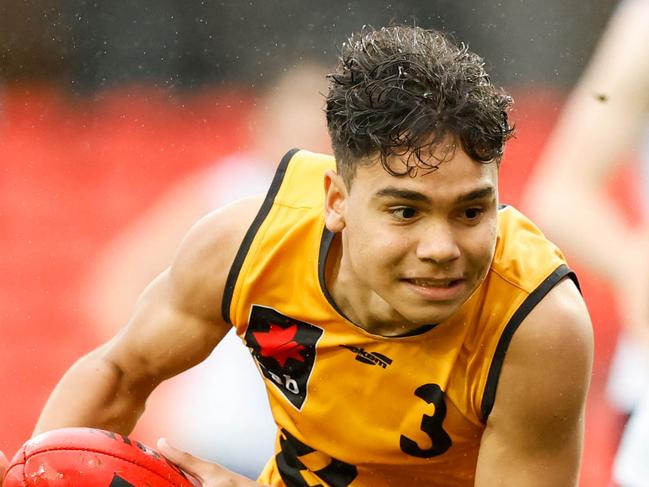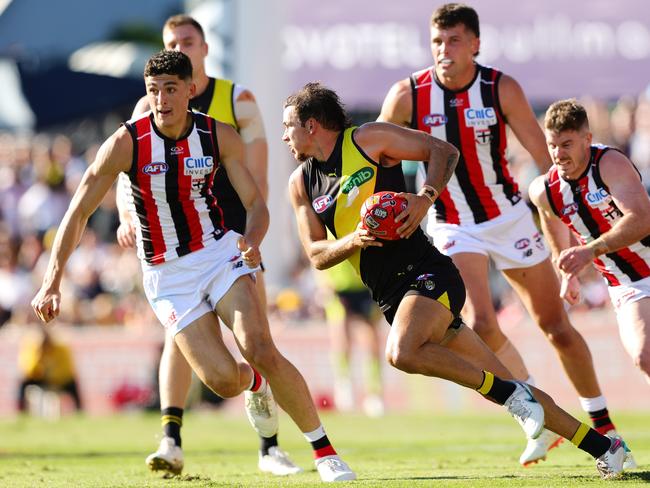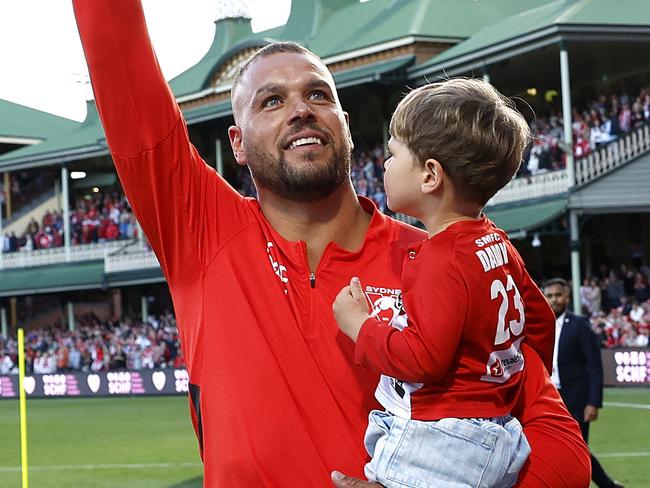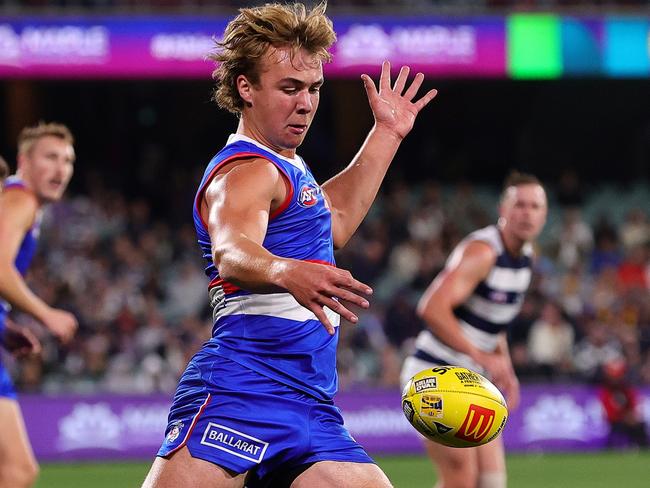Crisis looms on Indigenous player numbers at AFL level as pathways drop off due to funding, resources
The number of Indigenous players in the AFL has been on a steady decline since 2018, but looking ahead at future drafts SAM LANDSBERGER writes those numbers could be set to fall off a cliff.

AFL
Don't miss out on the headlines from AFL. Followed categories will be added to My News.
Western Australia has traditionally been a region stacked with Indigenous talent.
But last year there was only one Indigenous player in the state’s under-16 squad.
South Australia had none, while Victoria had only three.
The best Indigenous prospect eligible for the 2024 draft is Subiaco’s Malakai Champion.
But recruiters say even he faces a challenge to get drafted.
The dearth of Indigenous talent in last year’s under-16 squads foreshadows that both the 2025 and 2026 drafts will also be light on for prospects.
The AFL knows it has a looming problem. Indigenous player numbers have already started to decline.
So on March 14 the league summoned at least one member from all 18 AFL and AFLW list management and recruiting teams to Marvel Stadium for a “cultural session and discussion”.
The 50-minute presentation was led by AFL executive general manager of inclusion and social policy Tanya Hosch, AFL senior policy manager Sean Gorman, AFL national Indigenous and multicultural engagement manager Paul Vandenbergh and AFL diversity programs lead Narelle Long.

The presentation was educational, and designed to boost the number of Indigenous footballers drafted to the AFL. But clubs broadly felt the session became a finger-pointing exercise.
They felt the AFL should have instead opened its ears to solutions from those on the frontline of recruiting, rather than apportioning blame.
AFL Academy coach Tarkyn Lockyer also presented on March 14 in what was perceived as a job justification.
“Well, save the $1 million you spend on that (AFL Academy) and put it into Indigenous programs and you’ll get more Indigenous (players) drafted,” one club official said in reference to Lockyer’s presentation.
“There’s a simple solution. Part of the problem is the pathways have been so severely hit by funding. They just don’t have the resources to go to country areas and relocate Indigenous boys at 15-16 because they’re so short-staffed.
“A lot of the staff have changed, so they’re all new and they’re not getting paid much.
“When you cut the network at that level, they’re not producing the same results.
“So an Indigenous kid might not come down to Perth until his 18th year, and he’s too far back for clubs to take a risk on him because of list sizes. He’s going to need a few years, so are you prepared to have a long-term investment? All of those issues are relevant.”
The AFL Academy is stacked with father-sons and northern academy boys who are already receiving extra development.

The double-dipping of resources on those prospects is compounded by what clubs say are token players fed into the academy from Tasmania, New South Wales and Queensland, many of whom wind up in state leagues because they are simply not at a draftable standard.
Clubs believe the lack of resources makes it impossible for Indigenous kids from remote areas to travel more than 200km to attend training.
Relocating Indigenous boys to private schools in major cities helped the development of the likes of Daniel Rioli (St Patrick’s College), Cyril Rioli, Jy Simpkin, Jamarra Ugle-Hagan (Scotch College), Kysaiah Pickett (Prince Alfred College) and Steven May (Melbourne Grammar). Essendon twins Alwyn Davey Jr and Jayden Davey attended Xavier College before they were taken as father-sons in 2022.
In 2006 and 2008, a combined 44 Indigenous players were drafted to the AFL.
Those draft hauls included Shane Edwards, Alwyn Davey, Lindsay Thomas, Jarrod Harbrow, Stephen Hill, Chris Yarran, Liam Jones, Steven Motlop, Neville Jetta, Michael Walters, Liam Jurrah and Jeffrey Garlett.

Twenty out of the 44 were plucked from Western Australia.
Seven Indigenous players joined AFL lists in 2024 – Ryley Sanders (Western Bulldogs), Lance Collard (St Kilda), Mitch Edwards and Lawson Humphries (Geelong), Coen Livingstone (West Coast), Indhi Kirk (Sydney) and Josh Eyre (Collingwood). Just four of those – Sanders, Collard, Edwards and Livingstone – were drafted from the under-18s.
As seven entered the game in 2024, more than a dozen Indigenous players exited.
They included Lance Franklin, Anthony McDonald-Tipungwuti, Jed Anderson, Nakia Cockatoo, Nathan Wilson and Sam Petrevski-Seton.
In 2020, there were 87 Indigenous players on AFL lists. The recent delisting of Tarryn Thomas has left just 71 Indigenous players in the game.
Some of those are in the twilight of their careers. They include Bradley Hill, Chad Wingard, Tim Kelly, Joel Hamling, Marlion Pickett, Walters and Jones.
Many more are fringe players who are vulnerable to being delisted.
Matt Coulthard, Quinton Narkle, Isaac Keeler, Lloyd Johnston, Jamaine Jones, Brandan Parfitt, Conrad Williams and Robert Hansen Jr are all out of contract this year.
Retired champion Eddie Betts has voiced concerns that some Indigenous players do not feel culturally safe in the AFL. Perhaps some prospects are no longer pursuing AFL dreams because of the lived experiences of their childhood heroes.
Some clubs believe the AFL had passed the buck to clubs by creating Next Generation Academies and that did not appear to beworking.
Murray Bushrangers last year set up a Dungala program to support local Indigenous boys and girls transition into AFL talent pathway programs.

The program is designed to reach out to players from the age of 13 so they did not feel overwhelmed or uncomfortable when they arrived for pre-season tests and trials with Murray
Bushrangers talent boss Michael Wilson said in previous years Indigenous players had been too afraid to even get out of the car at the trials.
“There were too many kids there testing and they weren’t feeling confident enough to try out for the program – even though they’d been invited in,” he said.
Richmond is one club passionate about addressing the issue and Wilson said the Tigers were doing a power of work with the Bushies.
But the Dungala program is fuelled by goodwill rather than AFL funding.
“What we were able to do was lean into the goodwill of the Rumbalara Football and Netball Club,” Wilson said. “They provided buses for travel to our training base in Wangaratta and we used their facilities when the Dungala kids trained.
“It wasn’t really a significant cost in regards to setting the program up. But as it grows hopefully it will be and we can actually go to the AFL and say is there an opportunity to provide some support.
“But we’re really fortunate that in our region we have a lot of goodwill from community clubs and our coaches in the Bushrangers program.”
Of the 261 boys to play at least one game in last year’s AFL U16 national championships, there were 30 Indigenous players (11.5 per cent) – it was a similar percentage for girls (14.4 per cent).
With little Indigenous talent in the elite pathways, the AFL knows it has a crisis looming.
“We are focused on growing this number for future years,” AFL boss Laura Kane said last month. “We are working closely with list managers across all our clubs to grow our Indigenous talent pathway.’’
More Coverage
Originally published as Crisis looms on Indigenous player numbers at AFL level as pathways drop off due to funding, resources




